Milwaukee 7220-20 Handleiding
Milwaukee
Nietmachine
7220-20
Bekijk gratis de handleiding van Milwaukee 7220-20 (13 pagina’s), behorend tot de categorie Nietmachine. Deze gids werd als nuttig beoordeeld door 11 mensen en kreeg gemiddeld 4.3 sterren uit 6 reviews. Heb je een vraag over Milwaukee 7220-20 of wil je andere gebruikers van dit product iets vragen? Stel een vraag
Pagina 1/13

Cat. No. / No de cat.
7220-20
COIL ROOFING NAILER
CLOUEUSE À BOBINE POUR TOITURE
CLAVADORA PARA TECHADO CON ROLLO DE CLAVOS
OPERATOR'S MANUAL
MANUEL de L'UTILISATEUR
MANUAL del OPERADOR
WARNING To reduce the risk of injury, user must read and understand operator's manual.
AVERTISSEMENT An de réduire le risque de blessures, l'utilisateur doit lire et bien
comprendre le manuel.
ADVERTENCIA Para reducir el riesgo de lesiones, el usuario debe leer y entender el manual.

2
3
GENERAL SAFETY INSTRUCTIONS
DANGER
Important safety instructions. Save
these instructions pertaining to a
risk of injury or death.
WARNING
When using tools, basic precau-
tions should always be followed,
including the following:
GENERAL
•To reduce the risk of injury, read all instructions
before using the tool.
WORK AREA
•Keep the work area clean and well lighted. Cluttered
benches and dark areas increase the risk of injury.
•Do not operate the tool in explosive atmospheres,
such as in the presence of ammable liquids,
gases, or dust. The tool is able to create sparks
resulting in the ignition of the dust or fumes.
•Keep bystanders, children, and visitors away while
operating the tool. Distractions are able to result in
the loss of control of the tool.
•Know what is behind your workpiece. A fastener
could travel through the workpiece and out the other
side, striking a bystander and causing serious injury.
•
DANGER
Avoid performing operations where
the fastener may contact hidden
wiring. Contact with a “live” wire will make exposed
metal parts of the tool “live” and shock the opera-
tor, resulting in serious injury or death. Contact a
qualied electrician to ensure a safe work environ-
ment exists.
PERSONAL SAFETY
•Stay alert. Watch what you are doing and use com-
mon sense when operating the tool. Do not use the
tool while tired or under the inuence of drugs, alcohol,
or medication. A moment of inattention while operat-
ing the tool increases the risk of injury to persons.
•Dress properly. Do not wear loose clothing or jewelry.
Contain long hair. Keep hair, clothing, and gloves away
from moving parts. Loose clothes, jewelry, or long hair
increases the risk of injury to persons as a result of
being caught in moving parts.
•Avoid unintentional starting. Remove nger from
the trigger when not driving fasteners. Be sure the
trigger is not pulled before connecting to the air supply.
Do not carry the tool with your nger on the trigger or
connect the tool to the air supply with the trigger pulled.
•Do not overreach. Keep proper footing and balance
at all times. Proper footing and balance enables better
control of the tool in unexpected situations.
•Use safety equipment. A dust mask, non-skid safety
shoes and a hard hat used for appropriate conditions
will reduce personal injuries.
•The operator and other people in the work area
must wear eye protection in accordance with ANSI
Z87.1. Eye protection does not t all operators in the
same way. Make sure the eye protection chosen has
side shields or provides protection from ying debris
both from the front and sides. The employer is responsi-
ble for enforcing the use of eye protection by the opera-
tor and other people in the work area. When required,
wear head protection in accordance with ANSI Z89.1.
•Always wear ear protectors when using the tool
for extended periods. Prolonged exposure to high
intensity noise is able to cause hearing loss.
•Do not carry an air hose or a tool connected to an air
hose when climbing ladders, rigging or scaolding.
•Do not attach an air hose or tool connected to an
air hose to your body when working at elevated
heights. Attach the hose to the structure to reduce
the risk of loss of balance and injury if the hose shifts.
•Always assume that the tool contains fasteners.
Careless handling of the tool can result in unexpected
ring of fasteners and personal injury.
•Do not point the tool towards yourself or anyone
nearby. Unexpected triggering will discharge the fas-
tener causing an injury.
•Do not nail on top of another nail. This can cause
the nail to be deected and hit someone, or cause the
tool to react and result in a risk of injury to persons.
TOOL USE AND CARE
•Use clamps or another practical way to secure and
support the workpiece to a stable platform. Holding
the work by hand or against the body is unstable and
is able to lead to loss of control.
•Do not force the tool. Use the correct tool for the
application. The correct tool will do the job better and
safer at the rate for which the tool is designed.
•Do not use the tool if the trigger does not turn the
tool on or o. Any tool that cannot be controlled with
the trigger is dangerous and must be repaired.
•Disconnect the tool from the air source, then empty
the magazine before making adjustments, doing
tool maintenance, clearing jams, touching the
workpiece contact or tool is outside your supervi-
sion or control. Verify the tool is empty and there is no
residual pressure in the tool prior to performing these
actions. Such precautionary measures reduce the risk
of injury to persons.
•Disconnect the tool from the power source when
the fastener jams in the tool. While removing a
jammed fastener, the tool may be accidentally activated
if it is plugged in.
•Use caution while removing a jammed fastener.
The mechanism may be under compression and the
fastener may be forcefully discharged while attempting
to free a jammed condition.
•Store idle tools out of reach of children and other
untrained persons. A tool is dangerous in the hands
of untrained users.
•Maintain the tool with care. A properly maintained
tool reduces the risk of injury. If the tool has been
dropped, received a sharp blow, been run over, etc.,
perform the "Required Daily Testing" before further use.
•Check for misalignment or binding of moving
parts, breakage of parts, and any other condition
that aects the tool’s operation. If damaged, have
the tool serviced before using. Many accidents are
caused by poorly maintained tools. There is an in-
creased risk of the tool bursting if the tool is damaged.
•Use only those fasteners specically recommended.
Fasteners not identied for use with this tool by the tool
manufacturer are able to result in a risk of injury to
persons or tool damage when used in this tool. See
the "Specications" section for fastener requirements.
•Do not use this tool for fastening electrical cables.
It is not designed for electric cable installation and
may damage the insulation of electric cables thereby
causing electric shock or re hazards.
•Use only accessories that are identied by the
manufacturer for the specic tool model. Use of an
accessory not intended for use with the specic tool
model, increases the risk of injury to persons.
•Do not attempt to modify tool or defeat safety
measures. Serious injury could occur.
SERVICE
• a) Tool service must be performed only by qualied
repair personnel.
b) The wrench provided is for tightening screws
during "Required Daily Testing".
c) Use only identical replacement parts recom-
mended by the manufacturer.
•Use only the air tool lubricants supplied with the
tool or specied by the manufacturer. Do not use
other lubricants; they will damage the tool. See "Ac-
cessories" for a list of recommended air tool lubricants.
AIR SOURCE
•
DANGER
Do not use oxygen, combustible
gases or bottled gases as a power
source for this tool. The tool will explode and cause
death or serious injury.
•Never connect to an air source that is capable of
exceeding 200 psi. Over pressurizing the tool may
result in bursting, abnormal operation, breakage of
the tool or serious injury to persons. Use only clean,
dry, regulated compressed air at the rated pressure or
within the rated pressure range as marked on the tool.
Prior to using the tool, always verify that the air source
has been adjusted to the rated air pressure or within
the rated air-pressure range. Air compressors should
comply with ANSI B19.3.
SPECIFIC SAFETY INSTRUCTIONS
FOR NAILERS
•Use air supply hoses with a minimum working
pressure rating of 200 psi.
•Use pressure regulators to limit the air pressure supplied
to the tool. Set the regulators to no more than 120 psi.
•Install only hose couplings that will allow all pressure
to be removed from tool when disconnected from
the source. If the wrong tting is installed, pressure
may remain in the tool after disconnection, allowing it
to drive a fastener, possibly causing injury.
•Prior to each use, check workpiece contact and
trigger for correct operation. Do not disassemble or
clamp parts of the workpiece contact, trigger, or driving
mechanism. This will cause unexpected actuation,
resulting in serious injury.
•Never point the discharge area of the tool at any
body parts or at other people. Always assume the
tool is loaded and capable of driving a fastener.
•Do not actuate the tool unless the tool is placed
rmly against the workpiece. If the tool is not in contact
with the workpiece, the fastener may be deected away
from your target.
•Do not engage in horseplay. The discharged fasteners
are projectiles capable of causing serious injury.
•When using the tool, ensure the workpiece contact
is securely placed on the workpiece. Hold the tool
rmly and be prepared for the recoil.
•Do not remove, tamper with, or otherwise cause the
tool operating controls to become inoperable. This will
cause unexpected actuation, resulting in serious injury.
•Do not operate a tool if any portion of the tool
operating controls is inoperable, disconnected,
altered, or not working properly. This will cause
unexpected actuation, resulting in serious injury.
•Always keep hands and body away from discharge
area of the tool. Never attempt to clear a jammed
workpiece contact by grasping the discharge area of
the tool. Fasteners discharged from tool can cause
serious injury if they contact hands or body.
•Do not drive fasteners close to the edge of the
workpiece. Fasteners can slip o corners and edges or
penetrate through thin material, making them projectiles
capable of causing serious injury.
•Use the tool only for the intended purpose. Do not
abuse the tool. Do not use as a hammer, stamp or
engrave information onto parts, drop or impact the tool
or otherwise apply excess force to the tool in use. Do not
mount the tool to stands or modify it for stationary use.
•Do not carry tool by the air hose. Only carry the tool
by the handle with your nger o of the trigger.
• Always use common sense and be cautious when
using tools. It is not possible to anticipate every
situation that could result in a dangerous outcome.
Do not use this tool if you do not understand these
operating instructions or you feel the work is beyond
your capability; contact Milwaukee Tool or a trained
professional for additional information or training.
•Do not use this tool without the safety warning label
in place. If the label is damaged or missing, contact
MILWAUKEE for a free replacement.
FUNCTIONAL DESCRIPTION
1. Workpiece contact
2. Nail guide
3. Exhaust deector
4. Actuation selector
5. Trigger
6. 3/8" NPT quick
connector
7. Magazine cover
8. Depth of drive
adjustment
9. Fastener door lever
10. Nameplate/Warning
label (not shown)
11. Fastener door
2
8
3
7
10
6
11
9
4
5
1
SPECIFICATIONS
Cat. No. ..................................................... 7220-20
Operating Pressure ............................. min. 70 PSI
max. 120 PSI
Fastener Length .....................................min. 0.75"
max. 1.75"
Collation Angle...................................................15°
Fastener Size (Diameter) ............................ 0.120"
Air Consumption .............. 0.08 ft
3
/cycle at 100 PSI
Air Inlet .................................................... 3/8" NPT
Magazine Capacity .................................. 120 nails
Recommended Ambient
Operating Temperature ................... 0°F to 125°F
Product specificaties
| Merk: | Milwaukee |
| Categorie: | Nietmachine |
| Model: | 7220-20 |
Heb je hulp nodig?
Als je hulp nodig hebt met Milwaukee 7220-20 stel dan hieronder een vraag en andere gebruikers zullen je antwoorden
Handleiding Nietmachine Milwaukee

19 Augustus 2025
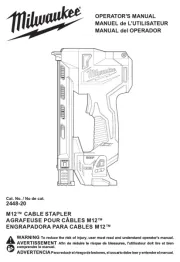
18 Augustus 2025

18 Augustus 2025
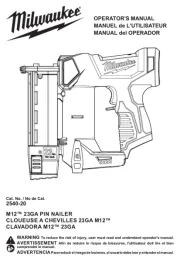
18 Augustus 2025
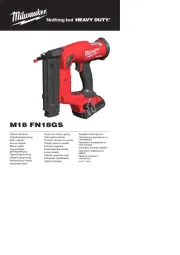
4 Augustus 2025
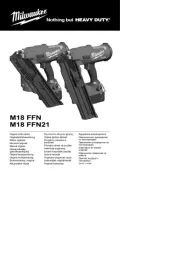
4 Augustus 2025
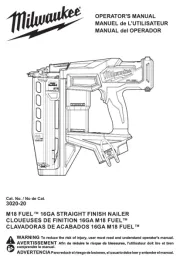
14 Juli 2025
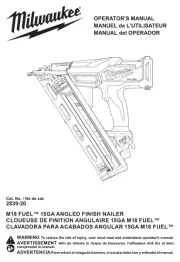
14 Juli 2025
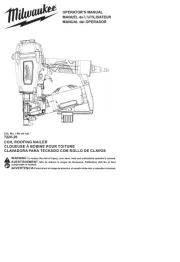
14 Juli 2025
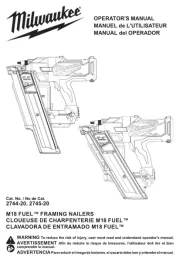
14 Juli 2025
Handleiding Nietmachine
- Targus
- Porter-Cable
- Fieldmann
- Rapoo
- Klein Tools
- Vonroc
- Swingline
- Mannesmann
- Craftsman
- Proline
- Smart365
- MSW
- Total
- Sun Joe
- Topcraft
Nieuwste handleidingen voor Nietmachine
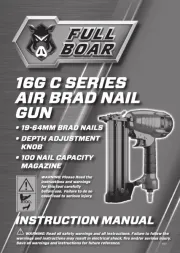
2 September 2025
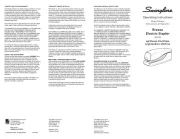
2 September 2025
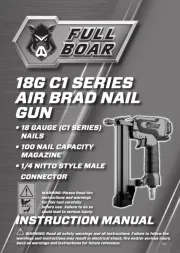
1 September 2025
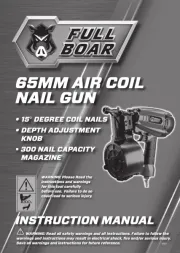
1 September 2025
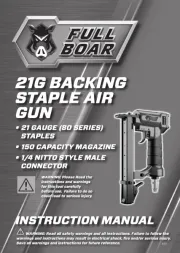
1 September 2025
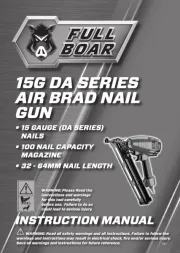
1 September 2025
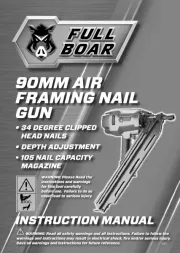
1 September 2025

26 Augustus 2025
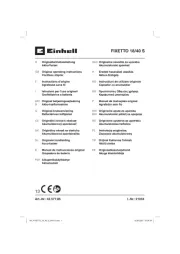
4 Augustus 2025

11 Juni 2025